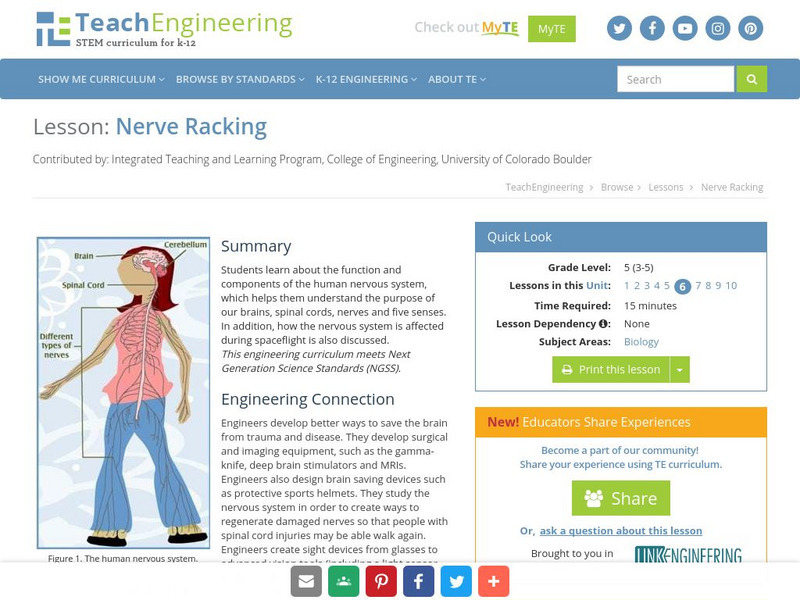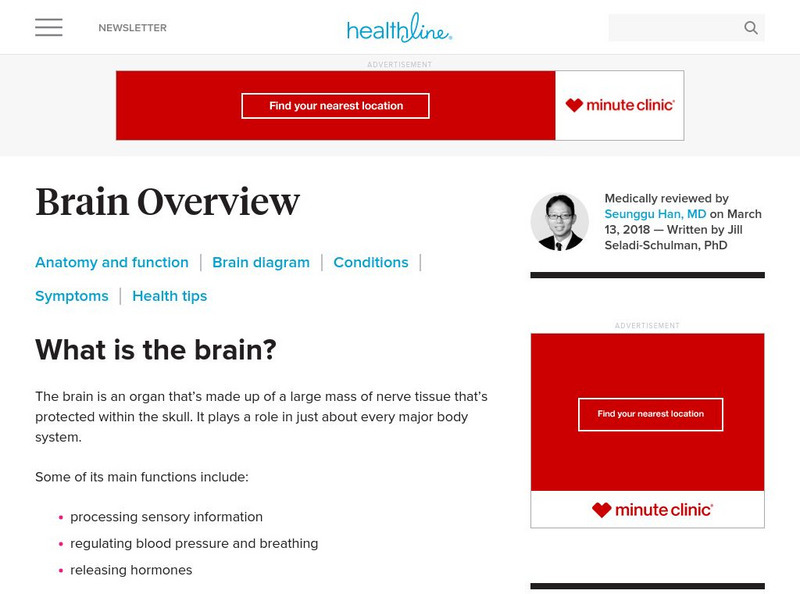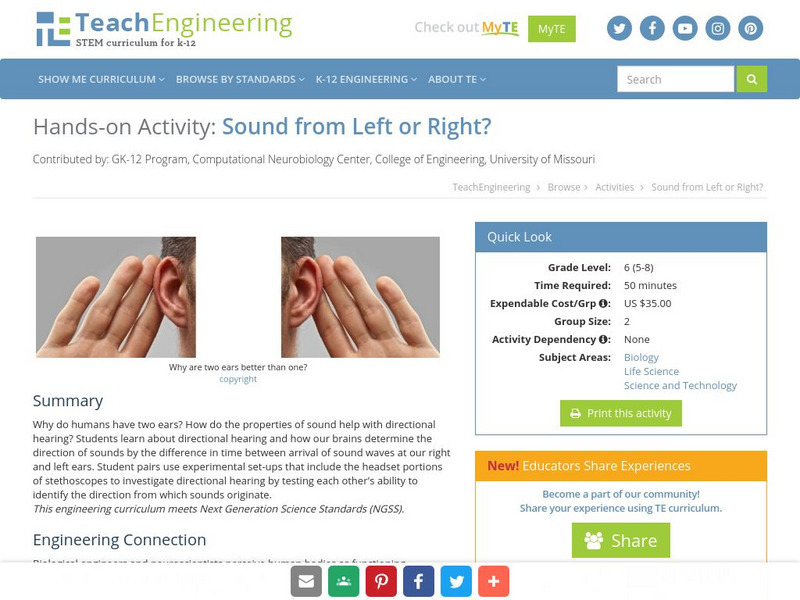Hi, what do you want to do?
TeachEngineering
Teach Engineering: Our Bodies Have Computers and Sensors
Students learn about the human body's system components, specifically its sensory systems, nervous system and brain, while comparing them to robot system components, such as sensors and computers. The unit's life sciences-to-engineering...
Other
Chungara (Arica): Surgical Procedures During Ancient Egyptian Mummification
How did mummification work? Brier and Wade attempt to use primary sources to replicate the mummification process on a human cadaver. Read about how they went about it and whether they were successful.
TeachEngineering
Teach Engineering: What Is a Sensor?
Young scholars gain a rigorous background in the primary human sensors, as preparation for comparing them to some electronic equivalents in the associated activity.
Cynthia J. O'Hora
Mrs. O's House: Concussion and Head Injury Action Plan
Concussions and head injuries are the buzz in sports today. Address concussion and head injuries in the classroom and provide students resources to research and report on findings.
Exploratorium
Exploratorium: Science Snacks: Proprioception
The human body has proprioceptors that send signals to the brain so that we are aware of our body's position and movements. Try these simple experiments to learn about proprioception and about other visual and tactile clues that assist...
Other
Partnership for a Drug Free America: Pcp
This site from the Partnership for a Drug-Free America is organized in question/answer format, this website provides a good introduction for students wanting to know about PCP and its hazardous effects on the human body and brain.
TeachEngineering
Teach Engineering: Nerve Racking
This lesson describes the function and components of the human nervous system. It helps students understand the purpose of our brain, spinal cord, nerves and the five senses. How the nervous system is affected during spaceflight is also...
Curated OER
Human
This site provides a great deal of information about the nervous system. In particular, the tools used to teach about the brain are helpful and effective.
Seeker
Seeker: Creating False Memories in Mice
Article reports on a study in which scientists implanted false memories in the minds of rats. Includes a video.
Other
Canal Kids: Saude (Health for Kids in Portuguese)
A very informative and fun site children can use to learn about taking care of their health. In addition to information about the body, the senses, the brain, vaccines, and healthy habits, the site provides a brief history of medicine....
Read Works
Read Works: Double Vision
[Free Registration/Login Required] An informational text about how 3-D televisions work. A question sheet is available to help students build skills in reading comprehension.
Other
Healthline: Three Dimensional Body Map: Nervous System
Rotatable view of the nervous system lets you examine the anatomy of the brain in 360 degrees.
University of Washington
Neuroscience for Kids Other Translations
Translations of Neuroscience for Kids, an excellent site on the brain and brain science by neuroscientists at the University of Washington. Includes Chinese (Mandarin and Cantonese), Portuguese, Italian, Slovene, and Korean. Translations...
Curated OER
Drug Mechanisms and Brain Function: The Antipsychotic Experience
Article on the effect of certain drugs on human personality. Article's foundation is in anti-psychotic research.
Curated OER
Drug Mechanisms and Brain Function: The Antipsychotic Experience
Article on the effect of certain drugs on human personality. Article's foundation is in anti-psychotic research.
TED Talks
Ted: Ted Ed: How Do We Smell?
An adult human can distinguish up to 10,000 odors. You use your nose to figure out what to eat, what to buy and even when it's time to take a shower. But how do the molecules in the air get translated into smells in your brain? This...
TeachEngineering
Teach Engineering: Sound From Left or Right?
Why do humans have two ears? How do the properties of sound help with directional hearing? Students learn about directional hearing and how our brains determine the direction of sounds by the difference in time between arrival of sound...
Other
Simply Psychology: Information Processing
Explains what is meant by information processing in the brain and the influence of computers on the thinking of cognitive psychologists. Describes the role of attentional capacity in humans' ability to process information and how models...
TED Talks
Ted: Ted Ed: Inside Your Computer
How does a computer work? The critical components of a computer are the peripherals (including the mouse), the input/output subsystem (which controls what and how much information comes in and out), and the central processing unit (the...



















